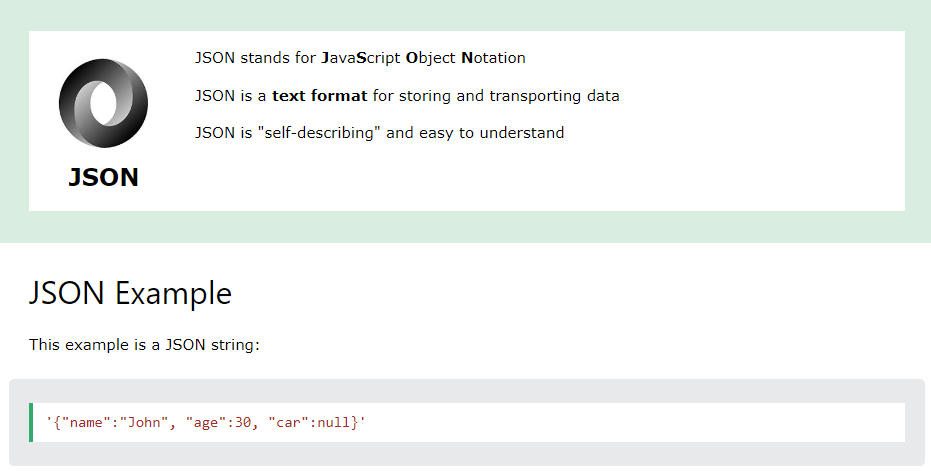On this page, We are going to learn about the full form of JSON and the meaning of JSON, As well as the meaning, definition, abbreviation, and acronym for JSON in different categories. So you should read this post till the end.
The Full Form of JSON: JavaScript Object Notation
JSON Stands for JavaScript Object Notation. JSON is a text-based data interchange format designed for the transmission of structured data. JSON is used to transfer data between web applications and web servers.
JSON files are saved under the name .json Extension. Internet Media Type of JSON is “application/JSON”. It supports JSON Array, Objects, String, Numbers, and Values.
It is language-independent. it can be written in any language like- Java, C++, etc. The json.org library has been included in the Android platform. By which we can create and process JS.ON files.
The JSON format was introduced in the 2000s by Douglas Crockford, the first website built on it was published in 2002, Yahoo launched its web services, JSON Parbhani in 2005, JSON became the ECMA international standard in 2013.

How is JSON used?
JSON (JavaScript Object Notation) is a lightweight data-interchange format. It is easy for humans to read and write. It is also easy for machines to parse and generate. JSON is based on a subset of the JavaScript language, and most JavaScript programmers are familiar with it.
JSON is used in many different ways. For example, it is often used to transfer data between a web server and a browser. When a user requests a web page, the web server sends the HTML code for the page, as well as any associated images, CSS files, and JavaScript code. The browser then parses the HTML and displays the page.
However, sometimes the server needs to send data to the browser that is not contained in the HTML code. For example, the server might need to send the results of a database query to the browser. In this case, the server would send the data in JSON format. The browser would then parse the JSON and display the data.
JSON is also used in mobile applications. For example, the JSON format is often used to store data in a mobile app’s database.
Objects can be represented more efficiently in JSON than in XML. The efficiency of JSON has helped it to become a popular choice for web applications, currently, JSON is used instead of XML. Let’s understand JSON with an example
JSON Formate
{
"Computer": {
"name": "My PC",
"components": {
"cpu": "Intel i7 2.4GHz", "ram": "12GB", "storage": "2TB HDD"
}
}
}
XML Formate
<computer> <name>My PC</name> <components> <cpu>Intel i7 2.4GHz</cpu> <ram>12GB</ram> <storage>2TB HDD</storage> </components> </computer>
Why use JSON in programming?
Even Ajax applications typically use JSON, although technically Ajax stands for “Asynchronous JavaScript and XML”.
While the difference between XML and JSON may be negligible for small applications, the low overhead of JSON can help reduce bandwidth and other system resources used by high-traffic websites.
- JSON has straight syntax.
- JSON is easy to create and manipulate.
- JSON is easy to read and write.
- JSON is natively recognized by JavaScript.
- JSON provides support for all browsers.
- JSON is supported by most backend technologies.
- It allows you to transmit and transmit structured data using a network connection.
- You can natively parse in JavaScript using the eval() function.
- You can use it with modern programming languages to convert JSON.
Features of JSON
- Easy to use: A high-level mask is provided by the JSON API for simplifying common use cases.
- Performance: Due to its small memory footprint, JSON is quite fast, especially for large object graphs.
- Free tool: The JSON library is open source and free to use.
- Strings: It supports JSON Array, Object, String, Number, and Values
- Dependency: JSON library does not require any other library for processing.
What are the benefits of using JSON?
JSON, or JavaScript Object Notation, is a lightweight data-interchange format. It is easy for humans to read and write, and for machines to parse and generate.
JSON is a language-independent text format that uses curly braces { } to delimit objects, and arrays are denoted by square brackets [ ]. JSON is based on the JavaScript programming language, but it can be used with any programming language. There are many benefits to using JSON.
- It is a human-readable format, so it is easy to understand and debug.
- JSON is also easy to generate and parse, making it a good choice for data interchange.
- JSON is lightweight and efficient, and it can be used with any programming language.
JSON is a versatile and popular data interchange format, used by a wide range of applications and technologies. Its simple, easy-to-read format makes it a popular choice for data storage and communication.
